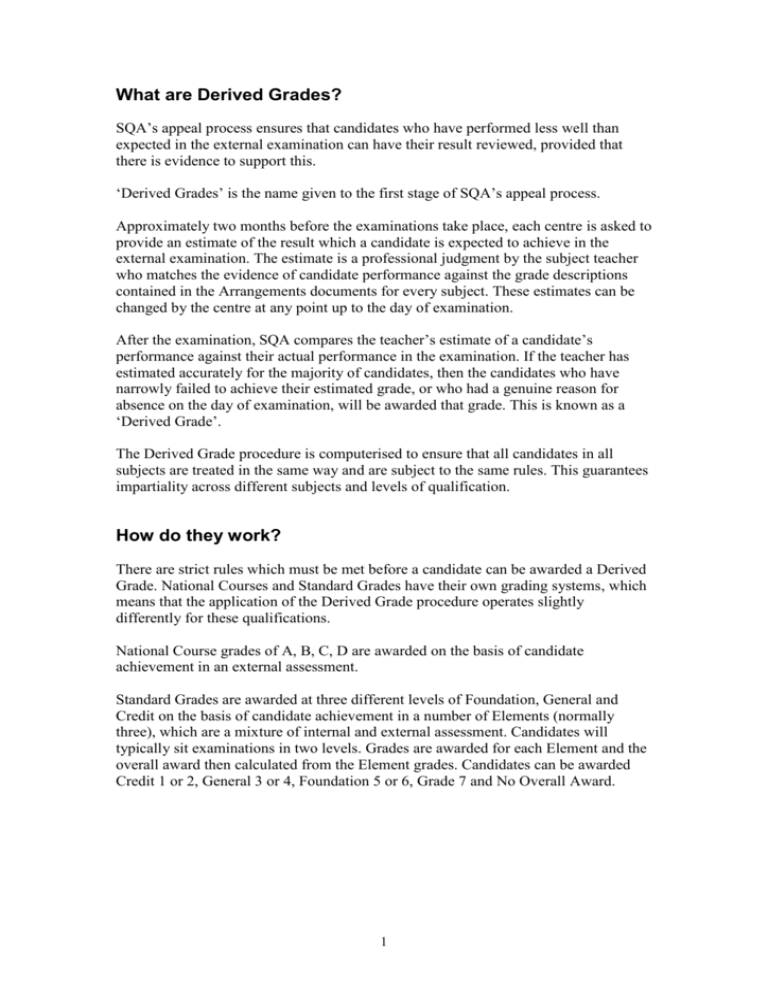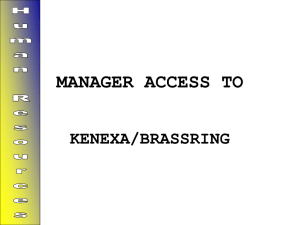Introduction to Derived Grades
advertisement

What are Derived Grades? SQA’s appeal process ensures that candidates who have performed less well than expected in the external examination can have their result reviewed, provided that there is evidence to support this. ‘Derived Grades’ is the name given to the first stage of SQA’s appeal process. Approximately two months before the examinations take place, each centre is asked to provide an estimate of the result which a candidate is expected to achieve in the external examination. The estimate is a professional judgment by the subject teacher who matches the evidence of candidate performance against the grade descriptions contained in the Arrangements documents for every subject. These estimates can be changed by the centre at any point up to the day of examination. After the examination, SQA compares the teacher’s estimate of a candidate’s performance against their actual performance in the examination. If the teacher has estimated accurately for the majority of candidates, then the candidates who have narrowly failed to achieve their estimated grade, or who had a genuine reason for absence on the day of examination, will be awarded that grade. This is known as a ‘Derived Grade’. The Derived Grade procedure is computerised to ensure that all candidates in all subjects are treated in the same way and are subject to the same rules. This guarantees impartiality across different subjects and levels of qualification. How do they work? There are strict rules which must be met before a candidate can be awarded a Derived Grade. National Courses and Standard Grades have their own grading systems, which means that the application of the Derived Grade procedure operates slightly differently for these qualifications. National Course grades of A, B, C, D are awarded on the basis of candidate achievement in an external assessment. Standard Grades are awarded at three different levels of Foundation, General and Credit on the basis of candidate achievement in a number of Elements (normally three), which are a mixture of internal and external assessment. Candidates will typically sit examinations in two levels. Grades are awarded for each Element and the overall award then calculated from the Element grades. Candidates can be awarded Credit 1 or 2, General 3 or 4, Foundation 5 or 6, Grade 7 and No Overall Award. 1 National Courses In National Courses grades are derived for a Course if a centre has six or more candidates with an estimate at the same grade, the teacher must estimate correctly the results for at least 60% of these candidates if a centre has less than six candidates with an estimate at the same grade, the teacher must estimate correctly the results for at least 75% of these candidates if these rules are met, then a National Course candidate who has achieved an examination grade which is one grade lower than their teacher estimated (eg estimated at Grade A and achieved Grade B) will have their result upgraded If a candidate has achieved one grade lower than estimated in the examination but the centre has not met the strict rules for Derived Grades, an appeal can still be made for this candidate. In accordance with the rules for appeals, the centre must submit the evidence on which they based the estimate for consideration by the examining team. Standard Grades In Standard Grade, grades are derived for an Element of a Course if a centre has six or more candidates with an estimate at the same grade, the results for at least 60% of these candidates must be the estimated grade or the grade above (eg estimated at grade 2 but achieving grade 2 or grade 1) if a centre has less than six candidates with an estimate at the same grade, the results for at least 75% of these candidates must be the estimated grade or the grade above (eg estimated at grade 2 but achieving grade 2 or grade 1) if these rules are met, then a Standard Grade candidate who has achieved an examination grade which is one or two grades lower than their teacher estimated (eg estimated at Credit 1 and achieved General 3) can have their result upgraded, provided that he or she has taken the examination paper to which the estimate relates If a candidate has achieved one or two grades lower than estimated in the examination but the centre has not met the strict rules for Derived Grades, an appeal can still be made for this candidate. In accordance with the rules for appeals, the centre must submit the evidence on which they based the estimate for consideration by the examining team. Absentees Candidates who had a genuine reason for absence on the day of examination may be awarded their estimated grade by the Derived Grade procedure. If, however, the centre has not met the rules for Derived Grades, the evidence for these candidates will be scrutinised by the examining team in advance of the full appeal process. 2 Why do we have Derived Grades? The basis for Derived Grades is that the accuracy of the teacher’s estimates makes it highly likely that such candidates would succeed at the formal appeal stage where the candidate’s own work is considered by examiners. The Derived Grade procedure therefore automates and standardises the first stage of the appeal process and speeds up the awarding process for candidates in a fair and efficient way. It has the additional benefit of using the limited time available for examining teams more efficiently, as they can focus on less clear-cut cases. How many Derived Grades are awarded? The number of Derived Grades which are awarded annually is around 10% of all Standard Grade Element entries and around 2% of National Courses entries. Further information on Derived Grades is contained in Research Bulletin 11: Evaluation of the 2003–4 derived grade procedure and Research Bulletin 14: Frequently asked questions on Derived Grades. These documents are available in the Research and Information section of the website. Excel Tables Nine tables provide data by centre type, subject and level. Two points should be noted: in all tables containing data on National Courses, the number of entries does not represent candidate numbers. Most National Course candidates take 3–5 subjects, and each subject is counted as an entry in all tables containing information on Standard Grade, the number of Elements does not represent candidate numbers. Most Standard Grade candidates sit 5–8 subjects, each of which normally contains three Elements. Each Element is counted as a separate entry 3





